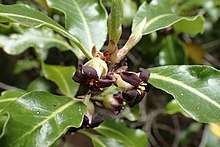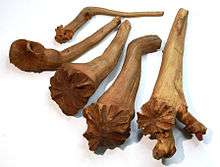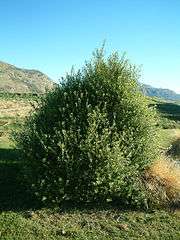Pittosporum tenuifolium
Pittosporum tenuifolium is a small evergreen tree – up to 10 m (33 ft) – commonly known as kōhūhū and black matipo, and by other Māori names kohukohu and tawhiwhi. Its small, very dark, reddish-purple flowers generally go unnoticed, and are scented only at night. The Latin tenuifolium means "slender-leaved"[6]
| Pittosporum tenuifolium | |
|---|---|
| Scientific classification | |
| Kingdom: | |
| Division: | |
| Class: | |
| Order: | |
| Family: | |
| Genus: | |
| Species: | tenuifolium |
| Binomial name | |
| Pittosporum tenuifolium | |
| Synonyms | |
|
Matipo[1]
| |
Description
The scientific name of kōhūhū is a good starting point to find out more about the physical characteristics of the species. Pittosporum translates to tarry – pittos – seed – sporum,[7] a reference to the sticky fluid that encases the seeds[2] and tenuifolium means thin – tenui – leaf – folium.[7]
Kōhūhū is a bush or small tree that grows up to around 8–10 metres tall. The trunk is slender (30–40 cm diameter) with a mottled dark grey bark color[2] that progressively turns black towards the tips of the branches[8]
The leaf coverage is compact in kōhūhū; the leaves’ arrangement on a stem is alternate[2] and the petiole short.[2] The leaves themselves are usually small – 2–4 cm long by 1–2 cm wide – but can grow up to 7 cm long.[2] The edges are undulated and the leaf shape can range from oval to almost circular.[8] Young leaves are covered in a layer of fine hairs that gets shed as the leaves grow.[2] Adult leaves have a smooth, glossy texture.[9] The colouration of the foliage is a silvery green,[8] darker on the upper side and lighter underneath.[9] The midrib of the leaf and its smaller lateral veins are whiteish and quite visible on the upper side of the leaf.[2]
Kōhūhū has small – around 1 cm in diameter – dark coloured flowers.[8] The colour ranges from dark-red[9] to dark-purple[8] turning almost black as the flowers age.[2] On rare occasions, the colour can be red or yellow.[8] The flowers develop from lateral buds, either individually or in clumps,[8] and can be male or bisexual.[8]
The flowers are filled with nectar and exude a honey scented fragrance in the evenings with the scent being more obvious in slightly damp conditions.[2] This attracts moths and night flying insects, and it is believed these insects help with pollination.[2]
Fertilised flowers develop into small – around 1.2 cm in diameter – [2] globe shaped fruits.[10] The fruit is covered in a small layer of hairs during early maturation that is progressively discarded as the capsule ripens.[2] In the ripening process the capsule shrinks, hardens up and turns almost black, splitting into two or three segments when ripened.[2] Inside are black seeds, encased in a very sticky substance.[2] The stickiness of the seeds is likely to help with seed dispersal.
Distribution
Natural global range
Kōhūhū is endemic to New Zealand.[2]
New Zealand range
Kōhūhū is well spread all over New Zealand, being absent only to the west of the Southern Alps[10] and Stewart Island.[2]
Habitat preferences
Kōhūhū is found growing wild in coastal and lower mountain forest areas up to an altitude of 900 m.[11]
Kōhūhū grows particularly quickly at forest edges[8] located at the bottom of high terraces,[2] and can also be found growing in riverbeds.[2] It grows readily in forested areas that have been disturbed[8] or in reverting farmland, playing an important role in ecological succession.[2]
Life cycle/Phenology
_capsule.jpg)
Most of the plants in the genus Pittosporum are easily propagated from seed, but germination may be slow.[2] In horticultural production, the sticky substance coating the seeds is removed before sowing, as it acts as a germination inhibitor. The seeds are treated to simulate natural conditions for six weeks in order to improve germination rates.[2]
Kōhūhū is a relatively fast growing plant[2] growing from 0.5 metres to 3 metres within five years. The root system is shallow and spread out.[12] These characteristics make it ideal – when used in conjunction with another plants – for use in stream stabilisation[12] and erosion control.[13]
Flowering happens in late spring, from October to November, and the maturation of the fruit happens between mid-summer and autumn, from January to March.[14]
The seedlings of kōhūhū are unusual, as in some cases they have three or four seed leaves instead of the usual two.[9]
Diet and foraging
Kōhūhū is a hardy plant that can cope with poor conditions – poor soils, droughts and windy environments.[2] It is, however, a light-demanding plant[2] and prefers soils with good drainage in humid climates.[15] Planting it in damp conditions can cause winter leaf dropn,[15] which likely explains why kōhūhū is not found growing on the West Coast of New Zealand. In its role in ecological succession, kōhūhū is often found at an earlier stage than its relative lemonwood (another endemic Pittosporum), and usually inhabits less fertile soils.[2]
Predators, Parasites, and Diseases
Insects

There are over 50 insect species listed in the Plant-SyNZ database[16] that either feed on or parasitise kōhūhū – wasps, sucking bugs, flies, moths, butterflies, thrips, mites and beetles. There are also more than a dozen beetles that feed on the dead plant material.
Below are some species of interest, organised by feeding habits:
Pittosporum flower weevil – Aneuma rubricale –, a native insect, lays its eggs on the flower of kōhūhū; interestingly, only kōhūhū is chosen for this, even if the weevil feeds on other types of Pittosporum. As soon as the weevil’s larvae hatch, they start feeding on the stamens and ovaries of the flowers, switching to the leaves once they reach adulthood.[17]
An arrival from Australia, pittosporum shield bug – Monteithiella humeralis – [18] as well as the endemic pittosporum psyllid – Trioza vitreoradiata – [19] feed only on Pittosporum species, by attaching themselves to a suitable part of the plant and feeding on its sap. The psyllid leaves a trail of characteristic “beads” behind.
Cottony cushion scale – Icerya purchase –,[20] an Australian bug, soft wax scale – Ceroplastes destructor –, an import from overseas [21] and the Australian green shield bug – Glaucias amyoti –, native to New Zealand despite its name[22] also parasitise the Pittosporum species, but have a more varied range of hosts. All attach themselves to a suitable part of the plant and feed on its sap.
New Zealand flower thrips – Thrips obscuratus – feeds on leaves, flowers and young fruit of kōhūhū, by piercing plant cells and sucking their contents.[23]
Fungi
Pythium irregulare has been recorded as a pathogen of kōhūhū, causing foliar blight, rot, and eventually death.[24]
A recently discovered pathogen of kōhūhū that caused swelling of twigs – the fungus Elsinoe takoropuku – turned out to be a newly discovered species of fungi. The fungus was, so far, only found in association with kōhūhū.[25]
Cultural uses
Garden plant
_branch.jpg)
Kōhūhū is a popular garden plant in New Zealand and overseas, often used a hedge or as visual backdrop.[2] It is sometimes grown under the cultivar name 'Nigricans', so called because of its black stems. In horticulture it is valued for its coloured foliage (cultivated variations include purple, "silver" and variegated leaves), and for its tolerance of some horticulturally difficult growing conditions, including dry soils and shade (although in northwest Europe, cold and exposed situations do not suit it).
Several hybrids and cultivars have been developed[2] and five varieties won the Royal Horticultural Society's Award of Garden Merit due to their ability to cope in the growing conditions of the United Kingdom:[26]
Host of threatened wood rose

Kōhūhū has the potential to be used as the host of the threatened root parasite plant wood rose – Dactylanthus taylorii. Wood rose was recently successfully translocated and sown in the wild from seed, showing the largest success rate when planted in association with kōhūhū.[32]
Use by Māori
There are several recorded uses of kōhūhū by Māori. The resin and oils extracted from the leaves were used for their scent and were often mixed with ingredients sourced from other native trees in order to produce an oil of variable composition.[33] The resin was obtained by making cuts in the bark of the tree[2] and the leaves were crushed and mixed with other oils.[33] The oil was used to scent little pouches[2] or a dead bird skin,[33] often worn around the neck.[2] The oil was also used to scent houses and mats of people of high rank.[33]
In addition, kōhūhū was also used for medicinal purposes by Māori. The resin was mixed with other gums and chewed as a cure for bad breath and sores in the mouth.[34] Parts of the plants were used as topical treatment for relief of the symptoms of skin diseases.[2] Crushed leaves were also used as a poultice for ulcers.[35] The crushed bark was soaked in water and the resulting mixture used to treat breast or chest ailments, and the remaining liquid could be taken orally.[34] It was used, together with flax root, to make a brew used to treat fever, bleeding and bruising.[34] Validating its traditional uses as a medicine, a 2010 study indicated that kōhūhū does indeed possess some antimicrobial properties.[36]
Lastly, the branches of kōhūhū were used in important Māori life ceremonies, such as baptisms, and are still used for welcoming visitors to a marae.[33] Two of its common names, tāwhiri (“to wave to”) and rautāwhiri (“to wave a leaf”) reflect this.[33]
References
- Cockayne, L. (1967). New Zealand Plants and Their Story. Wellington, New Zealand: Government Printer.
- Wardle, J. (2011). Wardle's Native Trees of New Zealand and their story. Wellington, New Zealand: Bateson Publishing Limited.
- "Flora of New Zealand | Taxon Profile | Pittosporum tenuifolium". www.nzflora.info. Retrieved 2019-05-09.
- Foster, T. (2012). Plant Heritage New Zealand. Whangarei, New Zealand: Jeff Oliver Print.
- "Māori Plant Use Database Plant Use Details of Pittosporum tenuifolium". maoriplantuse.landcareresearch.co.nz. Retrieved 2019-05-09.
- Harrison, Lorraine (2012). RHS Latin for gardeners. United Kingdom: Mitchell Beazley. p. 224. ISBN 9781845337315.
- Crowe, Andrew. (1990). Native edible plants of New Zealand. Hodder and Stoughton. ISBN 0340508302. OCLC 768637129.
- Dawson, John, 1928- author. (2011). New Zealand's native trees. ISBN 9781877517013. OCLC 832592658.CS1 maint: multiple names: authors list (link)
- Foster, Tony, 1957- author. Plant heritage New Zealand = te whakapapa o nga rakau : interpreting the special features of native plants. ISBN 9780473219123. OCLC 840603084.CS1 maint: multiple names: authors list (link)
- Allan, H. H. (Harry Howard), 1882-1957. (1982). Flora of New Zealand. Psilopsida, Lycopsida, Filicopsida, Gymnospermae, Dicotyledones. Government Printer. ISBN 0477010563. OCLC 760926043.CS1 maint: multiple names: authors list (link)
- Miller, Diana M. "Pittosporum tenuifolium hybrids and cultivars". Royal Horticultural Society. Retrieved 27 May 2013.
- "Kohuhu Pittosporum tenuifolium" (PDF). Landcare Research.
- Marden, M.; Lambie, S.; Rowan, D. (2018-07-11). "Root system attributes of 12 juvenile indigenous early colonising shrub and tree species with potential for mitigating erosion in New Zealand". New Zealand Journal of Forestry Science. 48 (1). doi:10.1186/s40490-018-0115-9. ISSN 1179-5395.
- "Flora of New Zealand | Taxon Profile | Pittosporum tenuifolium". www.nzflora.info. Retrieved 2019-05-13.
- Cave, Yvonne. (1999). The gardener's encyclopaedia of New Zealand native plants. Paddison, Valda. Auckland: Random House. ISBN 1869620437. OCLC 44289301.
- "PlantSynz - Invertebrate herbivore biodiversity assessment tool: Database". Plant-SyNZ. Retrieved 2019-05-05.
- Martin, N. A. (2018). "Pittosporum flower weevil - Aneuma rubricale". Interesting Insects and other Invertebrates.
- Martin, N. A. (2018). "Factsheet: Pittosporum shield bug - Monteithiella humeralis". Interesting Insects & other Invertebrates. Retrieved 2019-05-05.
- Martin, N. A. (2018). "Factsheet: Pittosporum psyllid - Trioza vitreoradiata". Interesting Insects & other Invertebrates. Retrieved 2019-05-05.
- Martin, N. A. (2018). "Factsheet: Cottony cushion scale - Icerya purchasi". Interesting Insects & other Invertebrates. Retrieved 2019-05-05.
- Martin, N. A. (2018). "Factsheet: Soft wax scale - Ceroplastes destructor". Interesting Insects & other Invertebrates. Retrieved 2019-05-05.
- Martin, N. A. (2018). "Factsheet: Australasian green shield bug - Glaucias amyoti". Interesting Insects & other Invertebrates. Retrieved 2019-05-05.
- Martin, N. A. (2019). "Factsheet: New Zealand flower thrips - Thrips obscuratus". Interesting Insects & other Invertebrates. Retrieved 2019-05-05.
- Guarnaccia, Vladimiro; Hansen, Zachariah R.; Aiello, Dalia; Smart, Christine D.; Polizzi, Giancarlo (2015). "First Detection of Root Rot and Foliar Blight on Pittosporum (Pittosporum tenuifolium) Caused by Pythium irregulare in Italy". Journal of Phytopathology. 163 (5): 411–414. doi:10.1111/jph.12290. ISSN 1439-0434.
- Ridley, G. S.; Ramsfield, T. D. (2005-11-01). "Elsinoe takoropuku sp. nov. infects twigs of Pittosporum tenuifolium in New Zealand". Mycologia. 97 (6): 1362–1364. doi:10.1080/15572536.2006.11832742. ISSN 0027-5514.
- "AGM Plants - Ornamental" (PDF). Royal Horticultural Society. July 2017. p. 79. Retrieved 2 May 2018.
- "RHS Plant Selector - Pittosporum tenuifolium 'Garnettii'". Retrieved 15 April 2020.
- "RHS Plant Selector - Pittosporum tenuifolium 'Irene Paterson'". Retrieved 15 April 2020.
- "RHS Plant Selector - Pittosporum tenuifolium 'Silver Queen'". Retrieved 15 April 2020.
- "RHS Plant Selector - Pittosporum tenuifolium 'Tom Thumb'". Retrieved 15 April 2020.
- "RHS Plant Selector - Pittosporum tenuifolium 'Warnham Gold'". Retrieved 15 April 2020.
- Holzapfel, Sebastian Avi; Dodgson, John; Rohan, Maheshwaran (2016-02-01). "Successful translocation of the threatened New Zealand root-holoparasite Dactylanthus taylorii (Mystropetalaceae)". Plant Ecology. 217 (2): 127–138. doi:10.1007/s11258-015-0556-7. ISSN 1573-5052.
- Riley, M. (1997). Māori Healing and Herbal. Paraparaumu, New Zealand: Viking Sevenseas N.Z. Ltd.
- Riley, M. (2018). Māori Healing Remedies. Paraparaumu, New Zealand: Viking Sevenseas N.Z. Ltd.
- Brooker, Cambie, Cooper, S.G., R. C., R. C. (1987). New Zealand Medicinal Plants. Auckland, New Zealand: Heinemann.CS1 maint: multiple names: authors list (link)
- Earl, Emma A.; Altaf, Mudassar; Murikoli, Rekha V.; Swift, Simon; O'Toole, Ronan (2010-06-10). "Native New Zealand plants with inhibitory activity towards Mycobacterium tuberculosis". BMC Complementary and Alternative Medicine. 10 (1): 25. doi:10.1186/1472-6882-10-25. ISSN 1472-6882. PMC 2891623. PMID 20537175.
External links
